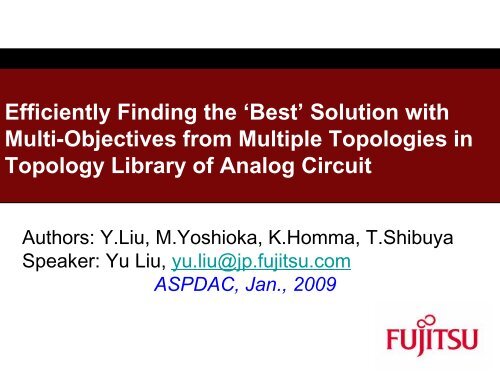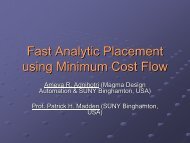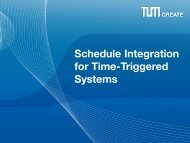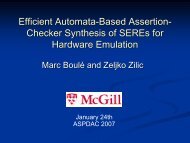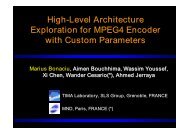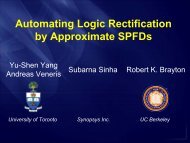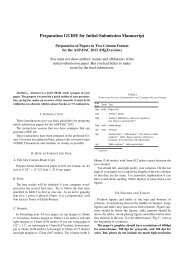Slides - ASP-DAC 2013
Slides - ASP-DAC 2013
Slides - ASP-DAC 2013
Create successful ePaper yourself
Turn your PDF publications into a flip-book with our unique Google optimized e-Paper software.
Efficiently Finding the ‘Best’ Solution withMulti-Objectives from Multiple Topologies inTopology Library of Analog CircuitAuthors: Y.Liu, M.Yoshioka, K.Homma, T.ShibuyaSpeaker: Yu Liu, yu.liu@jp.fujitsu.com<strong>ASP</strong><strong>DAC</strong>, Jan., 2009
Outline• Introduction• The ‘best’ solution of topology library ofanalog circuit‣ Abstract Pareto-front of topology library‣ Find the best solution for specification• Experiment• Summary
Outline• Introduction• The ‘best’ solution of topology library ofanalog circuit‣ Abstract Pareto-front of topology library‣ Find the best solution for specification• Experiment• Summary
BackgroundMatsuzawa, TitechPerf. 2 (e.g. power)OptimizeNot the best solutionthe best solutionOptimizePerf. 1(e.g. delay)Performancelimitation• Only the chips with higher performance, shorterdeveloping-period can win the market• Each block is needed to provide its best performances• Best solution of a block‣ Contribute better performance to system‣ Relax the constraints of other blocks
MotivationFeasibleperformance spaceof T3Perf. 2 (e.g. power)OptimizeSpec. changeUtopian Spec.Feasibleperformancespace of T1Non-optimizedSpec.OptimizeFeasibleperformance spaceof T2Perf.1 (e.g. delay)• Specification assignments in early design stage• For analog block, the first assigned specification maybe nonoptimizedor Utopia• The specification may also be changed• We provide an automatic design method to efficiently find thebest solution with multi-objectives from multiple candidates ofanalog topologies
Traditional Flow for Automatic DesignChangespec.ChangetopologyTopologyselectionSingle-objective singletopologyoptimizationtopology left?Spec.Meet spec.?Decided topologyand design variablesSPICEsimulatorTime-consumingPerf. 2 (smaller is bettere.g. power)Feasibleperformance spaceof T3Spec.Feasibleperformance spaceof T1bestFeasiblesolutionperformanSolutionce spaceSpec.of T2areaPerf.1 (smaller is better e.g. delay)• This flow works well to find asolution when the specification isachievable• Assignment of a good achievablespecification is difficult• Inefficient when specification ischanged• The output solution may not be thebest solution that the topologiescan provide
The Flow of This Worktopology 1Multi-objectivesingle-topologyoptimizationTopologyselectionSpec.Multi-objectivesingle-topologyoptimizationAbstract Pareto-front oftopology libraryFind best solution for Spec.Change Spec.Meet Spec.?Time-consumingDecided topologyand design variablestopology mMulti-objectivesingle-topologyoptimizationPerf. 2 (e.g. power)PerformancelimitationPerf.1 (e.g. delay)Spec.Solution• Perform the time-consumingoptimization not depending onthe detailed specification• Efficient to find the best solutionfrom multiple topologiesespecially in early design stagewhile the specification is notclear
Review: Pareto-FrontOptimizeobj2Pareto-frontADCBobj1OptimizeOptimizedsolutionUtopiasolution(gain, GBW, idd…)Non-optimalsolutionPareto-frontPerformance space (N-Dimensions)• The non-dominated solution set for multi-objectiveoptimization problem regarding to all objective‣ A dominate Ba pb⇔∀ia ≤ b ∧ ∃ a
Related Works• On abstraction algorithm of Pareto-front‣ [Stehr 03], [Mueller 05], [Tiwary 06], [Yu 07]• On high-level design using Pareto-front‣ [Tiwary 04], [Eeckelaert 07]• On sizing analog circuit through multiple topologies usingPareto-front‣ [Mcconaghy 07]‣ The final decision is manually made depending on the 2D or 3DPareto-front graph• We need an efficient tool to automatically find the bestsolution of multi-dimensional specification from themultiple candidates of analog topologies.
Outline• Introduction• The ‘best’ solution of topology library ofanalog circuit‣ Abstract Pareto-front of topology library‣ Find the best solution for specification• Experiment• Summary
Pareto-Front of Topology Library• Pareto-front of an analog topology(W0/L0= 12u/1u,C0=1pF, R0=1K….)Analog topologyIq=3mA, Av=80dB,CMRR=78dB..)Design variable space (M-Dimensions)• Pareto-front of topology library‣ A set of optimized solutionsPerformance space(N-Dimensions)‣ Non-dominated solutions of the achievable performances of allthe topologies in the libraryTopology 1Topology 2Design variable spaceTopology nPerformance space
Theorem• Theorem‣ The points on Pareto-front of topology library are also on one of thePareto-fronts of individual topology in the library.• Divide the abstraction of Pareto-front of topology library intotwo steps‣ Abstract Pareto-front of each topology‣ Abstract the Pareto-front of libraryTopology 1Topology 2Topology nDesign variable spacePerformance space
Abstract Pareto-Front Using Theorem• NSGA (Non-dominated SortingGenetic Algorithm)‣ Iteratively search the optimizedsolutions (generation) to find thesampling points on Pareto-front• Abstracting the Pareto-front oftopology library by definition‣ Once a topology in library ischanged, the evaluations of alltopologies have to be repeated• Abstracting the Pareto-front bythe theorem‣ Only need to evaluate thechanged topology‣ Note that the number ofevaluated data is proportional tothe number of design variables,it is efficient when some oftopologies in the library arechangedgeneration 1generation ngeneration 2
Outline• Introduction• The ‘best’ solution of topology library ofanalog circuit‣ Abstract Pareto-front of topology library‣ Find the best solution for specification• Experiment• Summary
Definition of the ‘Best’ Solution• The ‘best’ solution‣ The point on Pareto-front which is nearest to the specification innormalized distance‣ Superior or equal to the achievable specification in all theperformances‣ Achievable solution which is nearest to the Utopian specificationAchievablespecificationUtopianspecificationthe ‘best’ solution
Collinearity Theorem• Collinearity theorem [Kasprzak 01]‣ The internal point on Pareto-front b is the best solution if andonly if the specification s, b and the instantaneous center c arecollinear.
Calculate the Best Performance• Calculate the best performance having N-dimensions‣ Model Pareto-front by the equation‣ Calculate the best performance by solving the equationsextended from Collinearity theoremXXXnsbXX
Calculate the Best Solution• Topology decision‣ Topology’s Pareto-front includes the best performance• Search design variables‣ Locally model the performances pb with design variables‣ Search the design variables to minimize the normalizeddistance ||b-pb||‣ Example• Searching design variables by Nelder-Mead algorithm# of design variables: 5# of specification item :2
The Best Solution• Verify the calculated best solution via SPICE• Interpolatively find the best solution between thecalculated best solution and the best sampling point forspecial casesXXTopology AX XTopology BXXXXXXSpecial case1Special case2
Outline• Introduction• The ‘best’ solution of topology library ofanalog circuit‣ Abstract Pareto-front of topology library‣ Find the best solution for specification• Experiment• Summary
Case Study• Analog buffer in actualADC project for highdefinitionvideo application• System requirements‣ Capacitance load up to 5pF‣ Power supply down to1.05V‣ 65nm BSIM4 processparameters• Four topologies in library• Experiment environment‣ HSPICE simulator with highaccuracy options‣ 1.1GHz Sparcv9 CPU‣ 16G memory
Best Solution for 2D Specification• Simulation type: transient& AC• Pareto-front abstractiontime: 32.4 hours• Time for differentspecification: less than 1minute
Best Solution for 5D SpecificationPower supply=1.05V,✔✗✔✔✗✔✔✔✔✔Time for different specification: less than 1 minute
Outline• Introduction• The ‘best’ solution of topology library ofanalog circuit‣ Abstract Pareto-front of topology library‣ Find the best solution for specification• Experiment• Summary
Summary• Summaries‣ Introduce a method to automatically find the ‘best’ solution thatthe multiple topologies in topology library can produce‣ The efforts of time-consuming optimization stage are maximallypreserved for specification and topology change‣ This method is efficient to find the non-dominated optimizedsolution from multiple topologies especially in early design stage• Future works‣ Handle the variations of process and operation environment‣ Support the high-level design of mixed-signal SoC
Thank you!
Appendix: Normalization• Space transformation‣ Affine transformation• p’ = Sp + a• Move each point by a fixed distance in the same direction• Collinearity between points and the distance ratios along a line ispreserved• Linear scaling & shift


